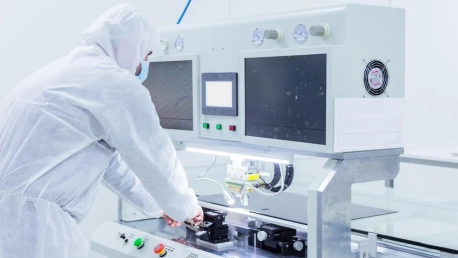The rapid pace and intricate processes of modern drug development call for efficiency, precision, and scalability—goals that are increasingly being met through the adoption of laboratory automation technologies. From target identification to quality control, these systems enhance biopharma research and production while addressing the pressing need for speed and reliability in the field. This article will delve into the transformative impact of lab automation on drug development.
The Indispensable Role of Automation in Biopharma
Laboratory automation is revolutionizing drug development by improving efficiency and ensuring consistency across various stages of the pipeline. Let’s explore how this trend is shaping the future of biopharma research.
Enhancing Efficiency at Every Stage
The advent of automated technologies has brought a renaissance in early-stage drug discovery. High-throughput screening (HTS) can now churn through thousands of compounds in a fraction of the time once needed, thanks to liquid handling robots, plate readers, and automated imaging. These machines work around the clock, ensuring that potential drug candidates are identified much faster than ever before. As such, lead optimization—another critical process that benefits from the precision and expediency of automation—is conducted with greater speed, allowing promising compounds to move swiftly into development pipelines.Robotic systems and automated informatics have also transformed the compound library management process. Libraries can now be stored and curated with minimal human intervention, ensuring the integrity of the compounds and their availability for screening campaigns at a moment’s notice. This massive increase in efficiency not only streamlines the drug discovery process but also helps pharmaceutical companies reduce overhead costs, as smaller teams can manage larger workloads thanks to automation.
Consistency and Quality Control
One of the cornerstone benefits of adopting laboratory automation within biopharma is the unmatched consistency it delivers. Robotics and computerized systems follow precise protocols without the variability inherent in human performance, ensuring that experimental results are reproducible and reliable. This is particularly crucial when it comes to adhering to stringent industry standards and regulatory requirements that demand consistency and traceability from batch to batch.Automation systems such as automated pipetting, plate handling, and even entire integrated robotic workstations play an instrumental role in maintaining quality control. They eliminate the manual handling of reagents and samples, which not only reduces the risk of cross-contamination but also ensures that exact volumes are dispensed every time, thereby enhancing the accuracy of assays and the robustness of data. With the quality of therapeutics directly linked to the precision of manufacturing and testing processes, automation isn’t just a luxury; it’s a necessity.
Breaking Through Bottlenecks
By addressing common bottlenecks in drug development, automated technologies are reshaping the paradigm of pharmaceutical research. We will examine the specific challenges that automation addresses and the benefits it brings.
High-Throughput Screening and Beyond
High-throughput screening is a prime example of a process that has historically been labor-intensive and slow. However, with the aid of laboratory automation, this task has transformed into an efficient operation that can evaluate vast libraries of compounds against various biological targets. The ability to quickly generate reliable data on compound activity serves as a robust foundation for downstream drug development processes.The integration of liquid handling robots, data processing software, and storage systems has enabled automated HTS platforms to operate with minimal human intervention. The result is not just an increase in the number of assays that can be run but also an improvement in the quality of the data collected. Decisions on which compounds to pursue can be made faster, which is of particular importance when addressing urgent medical needs, such as during a pandemic or for rare diseases where time is of the essence.
Customization and Advanced Therapies
The era of personalized medicine has brought forth an array of complex therapies tailored to the individual’s genetic makeup. Automation is at the forefront of this paradigm shift, handling the intricate workflows of RNA sequencing, genotyping, and various omics technologies that drive personalized medicine forward. This level of customization requires precision and the handling of copious amounts of patient data, seamlessly integrated into the workflow through laboratory information management systems (LIMS) and other informatics tools.Biologics, with their elaborate manufacturing processes, also benefit immensely from automation. The stringent conditions necessary for growing cell cultures, for instance, require exacting control that automation provides. This segment of drug development also generates large volumes of data, necessitating powerful data analysis tools. Harnessing the power of automation ensures that biopharma companies remain agile in the development of these innovative therapies, all the while managing the complexities that come with them.
Data Management and Predictive Analytics
The importance of efficient data management and the implementation of predictive analytics cannot be understated. Lab automation not only streamlines data collection but also enables more sophisticated analyses.
Tackling Biological Data Volumes
The management of massive data sets is a task that modern laboratories face daily. With the help of automated systems, the deluge of data generated by high-throughput processes and complex experiments is effectively harnessed. Integrated data solutions and cloud-based storage offer seamless data capture, curating, and mining capabilities. These sophisticated software systems not only support the aggregation of data but also streamline data analysis, leading to insights that would otherwise be obscured by the sheer volume of information.Efficient data management is especially critical when dealing with sensitive personal information in the realm of genomics and personalized medicine. Compliance with data protection regulations is made easier with automated systems that can ensure data integrity, access control, and audit trails. Furthermore, the use of advanced algorithms enables researchers to draw more nuanced conclusions from their data, facilitating a deeper understanding of disease mechanisms, drug interactions, and patient responses.
Paving the Way with AI and Machine Learning
Artificial Intelligence (AI) and machine learning (ML) are the engines driving the next phase of laboratory automation. Predictive analytics, enabled by AI, is transforming the decision-making process in drug development. Machine learning models that have been trained on existing data can now predict outcomes with remarkable accuracy, leading to a more targeted approach in the design of clinical trials and the development of therapeutic agents.The integration of AI with automated platforms is crucial in analyzing complex biological systems and identifying patterns that human researchers might overlook. For example, AI algorithms can facilitate the identification of novel biomarkers for disease or predict the safety and efficacy of new drug compounds. The predictive power of these tools not only enhances the drug discovery process but also minimizes risks associated with clinical development, making the path to pharmaceutical innovation both faster and safer.
From Lab Scale to Production Scale
Process development and scaling up production are key phases where automation proves indispensable. We will discuss the significance of lab automation in ensuring a smooth transition from research to market.
Streamlining Transition to Production
In the journey from laboratory to market, the ability to efficiently scale up production processes is pivotal. Laboratory automation provides valuable tools for process development, enabling researchers to refine procedures before they are transferred to a larger-scale manufacturing environment. Automation technologies facilitate the scaling of bioreactors, chromatography systems, and filling lines, ensuring that the transition from lab bench to production does not compromise product quality or safety.Furthermore, automation is critical in reacting to real-time demand and navigating health crises such as disease outbreaks. Whether it’s by accelerating vaccine production or quickly adjusting manufacturing lines for essential treatments, automation offers the agility needed to address emergent public health challenges. This nimbleness in production not only saves lives but also reflects a company’s commitment to responsiveness and responsibility, polishing its reputation in a competitive market.
Closed-System Automation for Sensitive Therapies
The challenges of developing cell and gene therapies are immense, yet the rewards are potentially life-changing. Closed-system automation provides an ideal solution in the manufacturing of these delicate therapeutics. These systems minimize human intervention, thereby reducing the risk of contamination while maintaining the sterile conditions required for manipulating live cells or vectors. Automation in this space goes beyond maintaining sterility; it also involves precision in the handling of cells, consistency in vector production, and adherence to stringent regulatory requirements. The complexity of these processes necessitates sophisticated control systems that can manage and monitor the environment and ensure the integrity of the product. For companies venturing into the realm of advanced therapeutics, leveraging closed-system automation is not just beneficial—it’s essential for success.
Standardization and Reproducibility for Safety and Quality
The ability to maintain standardization and reduce human error is crucial, particularly in complex therapeutic areas such as cell and gene therapies. Here, we highlight how automation reinforces confidence in experimental results.
Reducing Potential for Human Error
Human error in experimental settings is a pervasive challenge that automated systems adeptly address. Automation eliminates much of the manual processing that can lead to inconsistencies and mistakes. By doing so, it enhances the reproducibility of experiments and ensures the reliability of outcomes. This is particularly important in safety testing, where confidence in the results is non-negotiable.Automated analytical platforms, encompassing spectrophotometers, chromatography systems, and mass spectrometers, are routine features in modern labs. These platforms perform complex analyses with little room for operator-induced variability, ensuring that safety and efficacy data for new drugs meet the high standards demanded by regulatory agencies. By integrating such systems, laboratories can be confident in the accuracy and integrity of their data, paving the way for safer, more reliable drug products.
Confidence in Complex Product Testing
As the biopharma industry steps further into the development of complex biological products, the need for precise and controlled testing environments becomes increasingly pronounced. Automation technologies answer this call by providing standardized platforms for the rigorous testing required by these advanced therapies. In the cell and gene therapy space, even a slight deviation in testing protocols can lead to vastly different outcomes. Automated systems are specifically configured to conduct tests with high consistency, which is especially crucial when dealing with personalized therapies and their bespoke production techniques. As these therapies move closer to becoming mainstream, reliance on automation for quality control and safety testing will continue to grow, reflecting the essential nature of these systems in validating the promising future treatments.
The Future of Lab Automation: AI and Beyond
The intersection of laboratory automation and artificial intelligence holds the promise of remarkable advances in drug development. This section will forecast the future potentials and trends of this synergy.
AI-Enhanced Decision Making in Drug Discovery
The combination of automation and AI is setting the stage for a revolution in the efficiency and efficacy of drug discovery. AI algorithms, when applied to data gleaned from automated processes, can predict compound behavior, including efficacy and potential toxicity. This AI-enhanced predictive capability is not only refining the drug candidate selection process; it’s revolutionizing it by forecasting outcomes long before costly and time-consuming real-world testing begins.Moreover, AI can analyze complex biological and chemical datasets to uncover novel targets for drug development. It can guide scientists in the rational design of drugs, thereby enhancing the odds of clinical success. This predictive analytic approach is becoming increasingly sophisticated, with AI now contributing to personalized medicine advances by predicting how drug compounds might interact with genetic variants. As these technologies continue to evolve, they will radically transform the landscape of drug development, making it a more precise and personalized endeavor.
Revolutionizing Personalized Medicine Through Technology
In today’s fast-evolving pharmaceutical landscape, the development of new drugs is increasingly reliant on the integration of laboratory automation technologies. These sophisticated systems facilitate a range of activities from pinpointing potential drug targets to ensuring stringent quality controls. Their deployment is critical not only to enhance the precision and efficiency of the drug discovery and development process but also to keep pace with the industry’s demand for rapid and reliable outcomes.









